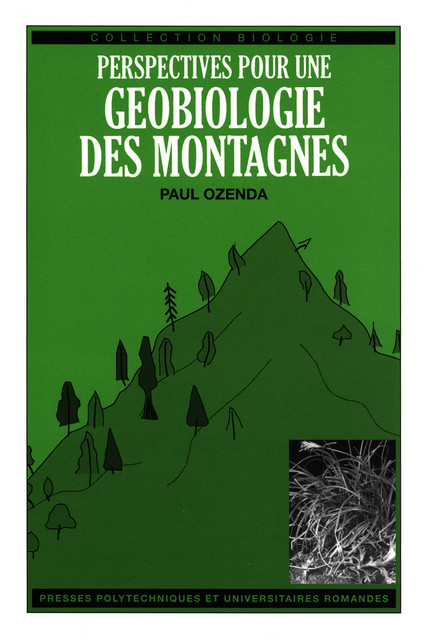Présentation
L'ouvrage de cet éminent spécialiste de la végétation montagneuse réunit l'expérience de terrain et synthétise la documentation (française et étrangère) accumulée au cours de 40 ans de travaux, d'enseignement et de direction de laboratoire. L'auteur entreprend une étude comparative de la biosphère dans les grandes chaînes de montagnes de la zone holartique, ovp se trouve la majorité des montagnes du monde.L'originalité des conditions de vie ainsi que la biodiversité du peuplement végétal de ces zones sont abondamment analysées, notamment en tant que descripteurs des conditions écologiques et guides pour une gestion de l'environnement montagnard. L'ouvrage introduit par ailleurs un concept nouveau de groupe subcontinental, celui d'orosystème. Une étude progressivement intégrée de la chaîne des Alpes puis des montagnes similaires d'Europe conduit enfin à la définition d'un ensemble appelé 'système médico-européen', éclairant d'une manière nouvelle des problèmes généraux d'écologie et de biocénographie.
Sommaire
- Avant-propos
- La montagne holarctique
- Originalité écologique de l'espace montagnard
- Du Subalpin à l'Alpin : incertitudes sur un écotone
- La montagne, observatoire privilégié de la biodiversité
- La diversité spécifique: éléments statistiques
- La diversité biocénotique dans les étages alpins
- Une démarche de biologie intégrative : la montagne médio-européenne
- Extension du concept d'orosystème
- Des complexes non résolus : systèmes ou nébuleuses
- Vers une vue unitaire
- Bibliographie
- Index.Abstract: This book sets out to provide a comparative study of the biosphere in the great mountain chains of the so-called holarctic, a region located between 30oN and 70oN, in which most of the world's mountains are to be found. The study is based essentially on an analysis of the vegetation as a descriptor of ecological conditions and as a guide to the management of the mountain environment. The first part of the book (chapters 1 to 3) deals with the unique nature of the conditions of mountain life, the ecological transcription of the notion of three-dimensionality and the little understood complexity of the ecotone formed by the upper limit of woody vegetation. It examines also the biodiversity of the vegetation of the vegetation of these chains (chapters 4 to 6), particularly with regard to the abundance and composition of the flora on the basis of altitude, their endemism and biocenonis in the alpine belt, with special emphasis on inter-chain comparisons. This work introduces the new concept of a subcontinental group, referred to here as an orosystem. A progressively integrative study of the Alps and then of similar mountains in Europe (chapter 7) leads on to the definition of a unit referred to as the Middle European System, which sheds new light on general problems of ecology and biogeography. The application of this concept to other eurasiatic groupings is set forth in chapter 8 and the difficulties in the case of more complex groupings (Central Asia, NW America) in chapter 9. To facilitate the transfer of data and conclusion from one system to another, chapter 10 proposes a universal nomenclature for the biological belts and their subdivisios.
Informations
Editeur : EPFL Press
Collection : Biologie
Publication : 3 avril 2002
Edition : 1ère édition
Support(s) : Livre papier
Nombre de pages Livre papier : 208
Format (en mm) Livre papier : 160 x 240
Poids (en grammes) : 450
Langue(s) : Français
EAN13 Livre papier : 9782880744939
Dans la même collection
Botanique systématique des plantes à fleur avec une introduction aux grands groupes de champignons
Rodolphe-Edouard Spichiger, Murielle Figeat, Daniel Jeanmonod
63,50 €
Les composés phénoliques des végétaux Un exemple de métabolites secondaires d'importance
Jean-Jacques Macheix, Annie Fleuriet, Christian Jay-Allemand
51,20 €
Ils ont aussi acheté
Sols et paysages Types de sols, fonctions et usages en Europe moyenne
Jean-Michel Gobat, Claire Guenat
61,65 €
Botanique systématique des plantes à fleur avec une introduction aux grands groupes de champignons
Rodolphe-Edouard Spichiger, Murielle Figeat, Daniel Jeanmonod
63,50 €
Paysage, lieu du temps Les forces à l’œuvre dans le paysage et son architecture
52,50 €
Hydrologie 1 Une science de la nature. Une gestion sociétale
André Musy, Christophe Higy, Emmanuel Reynard
57,00 €
Sur des thèmes similaires
Botanique systématique des plantes à fleur avec une introduction aux grands groupes de champignons
Rodolphe-Edouard Spichiger, Murielle Figeat, Daniel Jeanmonod
63,50 €
Les composés phénoliques des végétaux Un exemple de métabolites secondaires d'importance
Jean-Jacques Macheix, Annie Fleuriet, Christian Jay-Allemand
51,20 €






